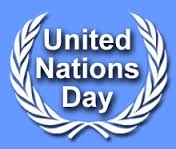Contents
United Nations Day 2015
UN Day marks the anniversary of the entry into force in 1945 of the UN Charter. With the ratification of this founding document by the majority of its signatories, including the five permanent members of the Security Council, the United Nations officially came into being.
24 October has been celebrated as United Nations Day since 1948. In 1971, the United Nations General Assembly recommended that the day be observed by Member States as a public holiday.
The United Nations is needed more than ever at this time of multiple crises. Poverty, disease, terrorism, discrimination and climate change are exacting a heavy toll. Millions of people continue to suffer deplorable exploitation through bonded labour, human trafficking, sexual slavery or unsafe conditions in factories, fields and mines. The global economy remains an uneven playing field.
The founding of the United Nations was a solemn pledge to the world’s people to end such assaults on human dignity, and lead the way to a better future. There have been painful setbacks, and there is much work ahead to realize the Charter’s vision. But we can take heart from our achievements.
The UN Millennium Development Goals have inspired the most successful anti-poverty campaign ever. United Nations treaties addressing inequality, torture and racism have protected people, while other agreements have safeguarded the environment. UN peacekeepers have separated hostile forces, our mediators have settled disputes and our humanitarian workers have delivered life-saving aid.
At this critical moment, let us reaffirm our commitment to empowering the marginalized and vulnerable. On United Nations Day, I call on Governments and individuals to work in common cause for the common good.
Ban Ki-moon
United Nations Day History:
In 1948, the United Nations General Assembly declared 24 October, the anniversary of the Charter of the United Nations, as which “shall be devoted to making known to the peoples of the world the aims and achievements of the United Nations and to gaining their support for” its work.
In 1971 the United Nations General Assembly adopted a further resolution (United Nations Resolution 2782) declaring that United Nations Day shall be an international holiday and recommended that it should be observed as a public holiday by all United Nations member states
The foundations for a “League of Nations” were laid in the Treaty of Versailles, which was one of the treaties to formally end World War I. The treaty was signed in Versailles, France, on June 28, 1919. The league aimed to encourage disarmament, prevent outbreaks of war, encourage negotiations and diplomatic measures to settle international disputes and to improve the quality of life around the world. However, the outbreak of World War II suggested that the League of Nations needed to take on a different form.
The ideas around the United Nations were developed in the last years of World War II, particularly during the UN Conference on International Organization in San Francisco, the United States, beginning on April 25, 1945. The UN was officially created when a UN charter was ratified on October 24 that year.
United Nations Day 2015 Celebrations History & Info
United Nations Day was first observed on October 24, 1948. The UN recommended that United Nations Day should be a public holiday in member states since 1971. There were also calls for United Nations Day to be an international public holiday to bring attention to the work, role and achievements of the UN and its family of specialized agencies. These have been spectacular, particularly in the fields of human rights, support in areas of famine, eradication of disease, promotion of health and settlement of refugees.
The UN does not work alone but together with many specialized agencies, including: the World Health Organization (WHO); the Food and Agriculture Organization (FAO); the United Nations Educational, Scientific and Cultural Organization (UNESCO); the United Nations Children’s Fund (UNICEF); International Labour Organization (ILO); United Nations High Commissioner for Refugees (UNHCR); and United Nations Human Rights Council (UNHRC).
United Nations Day 2015 Activities:
On this day, many activities are organized by all parts of the UN, particularly in the main offices in New York, the Hague (Netherlands), Geneva (Switzerland), Vienna (Austria) and Nairobi (Kenya). These include: concerts; flying the UN flag on important buildings; debates on the relevance of the work of the UN in modern times; and proclamations by state heads and other leaders.
The United Nations Day involves celebratory events such as food festivals showcasing food from around the world and cultural concerts. In-fact the United Nations Day concert is an important part of the day’s celebrations at the United Nations Headquarters. The concert for the year 2011 was sponsored by the Permanent Mission of Mongolia. It featured the traditional “long song” and “throat-singing”. The previously mentioned oral music forms have henceforth been included in the UNESOC’s list of the Intangible Cultural Heritage of Humanity. Cultural diversity is the drive-force behind greater development, a step towards leading a more enriching and wholesome intellectual, emotional, moral and spiritual life. It is an important economic growth. Cultural diversity is thus a huge asset and a grand alleviator of poverty and a potent precursor of sustainable development. Moreover a larger and more receptive acceptance and recognition of cultural diversity particularly through innovative use of media are conducive to a better understanding, cooperation and dialogue between nations and varying civilizations and culture.
Originally posted 2015-10-12 20:10:51.





